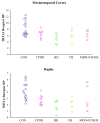Serotonin-1A receptor imaging in recurrent depression: replication and literature review
- PMID: 17921037
- PMCID: PMC2702715
- DOI: 10.1016/j.nucmedbio.2007.06.008
Serotonin-1A receptor imaging in recurrent depression: replication and literature review
Abstract
Introduction: Serotonin-1A receptor (5-HT1AR) function appears to be decreased in major depressive disorder (MDD) based on physiological responses to 5-HT1AR agonists in vivo and to 5-HT1AR binding in brain tissues postmortem or antemortem. We have previously assessed 5-HT1AR binding potential (BP) in depression using positron emission tomography (PET) and [carbonyl-(11)C]WAY-100635, and we have demonstrated reduced 5-HT1AR BP in the mesiotemporal cortex (MTC) and raphe in depressives with primary recurrent familial mood disorders (n=12) versus controls (n=8) [Drevets WC, Frank E, Price JC, Kupfer DJ, Holt D, Greer PJ, Huang Y, Gautier C, Mathis C. PET imaging of serotonin 1A receptor binding in depression. Biol Psychiatry 1999;46(10):1375-87]. These findings were replicated by some, but not other, studies performed in depressed samples that were more generally selected using criteria for MDD. In the current study, we attempted to replicate our previous findings in an independent sample of subjects selected according to the criteria for primary recurrent depression applied in our prior study.
Methods: Using PET and [carbonyl-(11)C]WAY-100635, 5-HT1AR BP was assessed in 16 depressed subjects and 8 healthy controls.
Results: Mean 5-HT1AR BP was reduced by 26% in the MTC (P<.005) and by 43% in the raphe (P<.001) in depressives versus controls.
Conclusions: These data replicate our original findings, which showed that BP was reduced by 27% in the MTC (P<.025) and by 42% in the raphe (P<.02) in depression. The magnitudes of these reductions in 5-HT1AR binding were similar to those found postmortem in 5-HT1AR mRNA concentrations in the hippocampus in MDD [López JF, Chalmers DT, Little KY, Watson SJ. Regulation of serotonin 1A, glucocorticoid, and mineralocorticoid receptor in rat and human hippocampus: implications for neurobiology of depression. Biol Psychiatry 1998;43:547-73] and in 5-HT1AR-binding capacity in the raphe in depressed suicide victims [Arango V, Underwood MD, Boldrini M, Tamir H, Kassir SA, Hsiung S, Chen JJ, Mann JJ. Serotonin 1A receptors, serotonin transporter binding and serotonin transporter mRNA expression in the brainstem of depressed suicide victims. Neuropsychopharmacology 2001;25(6):892-903]. There exists disagreement within the literature, however, regarding the presence and direction of 5-HT1AR-binding abnormalities in depression, which may be explained in some cases by differences in anatomical location (e.g., [Stockmeier CA, Shapiro LA, Dilley GE, Kolli TN, Friedman L, Rajkowska G. Increase in serotonin-1A autoreceptors in the midbrain of suicide victims with major depression--postmortem evidence for decreased serotonin activity. J Neurosci 1998;18(18):7394-401]) and in other cases by pathophysiological heterogeneity within MDD (e.g., some depressives hypersecrete cortisol, which would be expected to down-regulate 5-HT1AR expression [López JF, Chalmers DT, Little KY, Watson SJ. Regulation of serotonin 1A, glucocorticoid, and mineralocorticoid receptor in rat and human hippocampus: implications for neurobiology of depression. Biol Psychiatry 1998;43:547-73]). Antidepressant drug treatment does not alter these abnormalities in 5-HT1AR binding [Sargent PA, Kjaer KH, Bench CJ, Rabiner EA, Messa C, Meyer J, Gunn RN, Grasby PM, Cowen PJ. Brain serotonin1A receptor binding measured by positron emission tomography with [11C]WAY-100635: effects of depression and antidepressant treatment. Arch Gen Psychiatry 2000;57(2):174-80; Moses-Kolko EL, Price JC, Thase ME, Meltzer CC, Kupfer DJ, Mathis CA, Bogers WD, Berman SR, Houck PR, Schneider TN, Drevets WC. Measurement of 5-HT1A receptor binding in depressed adults before and after antidepressant drug treatment using positron emission tomography and [11C]WAY-100635. Synapse 2007;61(7):523-30] but may compensate for blunted 5-HT1AR function by increasing post-synaptic 5-HT1AR transmission [Chaput Y, de Montigny C, Blier P. Presynaptic and postsynaptic modifications of the serotonin system by long-term administration of antidepressant treatments. An in vivo electrophysiologic study in the rat. Neuropsychopharmacology 1991;5(4):219-29].
Figures


References
-
- Drevets WC, et al. PET imaging of serotonin 1A receptor binding in depression. Biol Psychiatry. 1999;46(10):1375–87. - PubMed
-
- Lopez JF, et al. Regulation of serotonin 1A, glucocorticoid, and mineralocorticoid receptor in rat and human hippocampus: implications for neurobiology of depression. Biol Psychiatry. 1998;43:547–573. - PubMed
-
- Arango V, et al. Serotonin 1A receptors, serotonin transporter binding and serotonin transporter mRNA expression in the brainstem of depressed suicide victims. Neuropsychopharmacology. 2001;25(6):892–903. - PubMed
-
- Sargent PA, et al. Brain serotonin1A receptor binding measured by positron emission tomography with [11C]WAY-100635: effects of depression and antidepressant treatment. Arch Gen Psychiatry. 2000;57(2):174–80. - PubMed
Publication types
MeSH terms
Substances
Grants and funding
LinkOut - more resources
Full Text Sources
Medical
Research Materials

